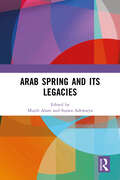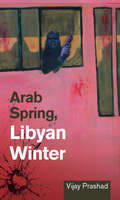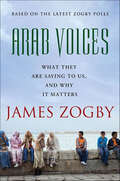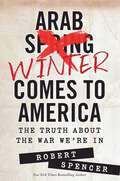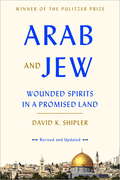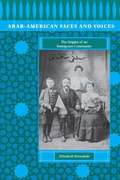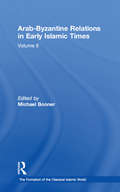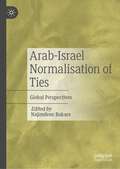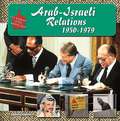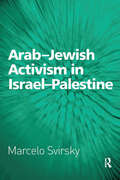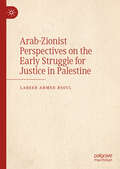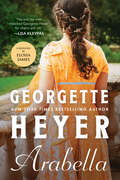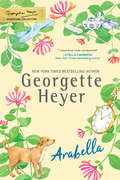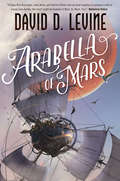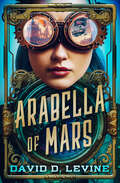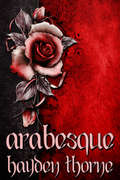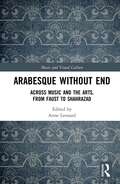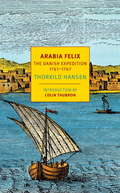- Table View
- List View
Arab Spring Then and Now: From Hope to Despair (History as it Happened)
by Robert Fisk Patrick Cockburn Kim Sengupta The IndependentThree award-winning journalists dive into the 2010 uprising that engulfed North Africa and the Middle East—and its aftermath.&“The big problem with the Middle East is to get people to see it from a different perspective; to stop accepting the American version of reality, i.e. &‘terror terror terror,&’ and instead look at the question of injustice. Seeing a different perspective, that of people who suffer for example.&”—Robert Fisk, The Independent In December 2010, the &“Tunisian Revolution&” touched off a wave of protests, riots, revolutions and civil wars throughout the Middle East. Initially the world hoped for positive change—democracy, free elections, and human rights. But, by 2012 the Arab Spring had morphed into &“Arab Winter&” bringing death, destruction, and despair. The Independent&’s Robert Fisk, Patrick Cockburn, and Kim Sengupta, among the most acclaimed Middle East correspondents of our generation, examine the events of this regional tsunami that threatens to have an impact on our world for years to come.
Arab Spring and Its Legacies
by Sujata Ashwarya Mujib AlamThe essays in this edited volume seek to understand the regional and international ramifications of the wave of protest demonstrations that swept across West Asia and North Africa in the early 2010s, both on the ground and online. Dissatisfaction with political repression and corruption, economic difficulties and inequities, and a desire for freedom and democracy all played a role in the Arab Spring uprisings. It deposed long-standing dictatorships, ushering in a period of insecurity and instability that would have long-term consequences for the region's political economy and international relations. Although the protests have ended, the legacy of that turbulent era will live on, most notably in the acceleration of regional change and transformation.Print edition not for sale in South Asia (India, Sri Lanka, Nepal, Bangladesh, Pakistan and Bhutan)
Arab Spring, Libyan Winter
by Vijay PrashadThe Arab Spring captivated the planet. Mass action overthrew Tunisia's Ben Ali and Egypt's Hosni Mubarak. The revolutionary wave spread to the far corners of the Arab world, from Morocco to Bahrain. It seemed as if all the authoritarian states would finally be freed, even those of the Arabian Peninsula. People's power had produced this wave, and continued to ride it out. In Libya, though, the new world order had different ideas. Social forces opposed to Muammar Qaddafi had begun to rebel, but they were weak. In came the French and the United States, with promises of glory. A deal followed with the Saudis, who then sent in their own forces to cut down the Bahraini revolution, and NATO began its assault, ushering in a Libyan Winter that cast its shadow over the Arab Spring. This brief, timely analysis situates the assault on Libya in the context of the winds of revolt that swept through the Middle East in the Spring of 2011. Vijay Prashad explores the recent history of the Qaddafi regime, the social forces who opposed him, and the role of the United Nations, NATO, and the rest of the world's superpowers in the bloody civil war that ensued. Vijay Prashad is the George and Martha Kellner Chair of South Asian History, and professor and director of international studies at Trinity College in Hartford, Connecticut. He is the author or editor of over a dozen books, including Karma of Brown Folk and, most recently, The Darker Nations: A People's History of the Third World.
Arab Spring: Modernity, Identity and Change (Critical Political Theory and Radical Practice)
by Eid Mohamed Dalia FahmyThis book provides systematic, integrated analyses of emergent social and cultural dynamics in the wake of the so-called Arab Spring, and looks closely at the narratives and experiences of a people as they confront crisis during a critical moment of transition. Providing an interdisciplinary approach to interconnections across regional and communal boundaries, this volume situates itself at the intersection of political science, cultural studies, media and film studies, and Middle Eastern studies, while offering some key critical revisions to dominant approaches in social and political theory. Through the unique contributions of each of its authors, this book will offer a much-needed addition to the study of Middle East politics and the Arab Spring. Moreover, although its specific focus is on the Arab context, its analysis will be of issues of significant relevance to a changing world order.
Arab Voices: What They Are Saying to Us, and Why it Matters
by James ZogbyThe Arab World is a region that has been vastly misunderstood in the West. Arab Voices asks the questions, collects the answers, and shares the results that will help us see Arabs clearly. The book will bring into stark relief the myths, assumptions, and biases that hold us back from understanding this important people. Here, James Zogby debuts a brand new, comprehensive poll, bringing numbers to life so that we can base policy and perception on the real world, rather than on a conjured reality.Based on a new poll run by Zogby International exclusively for this book, some of the surprising results revealed include:* Despite the frustration with the peace process and the number of wars of the past few years, 74% of Arabs still support a two state solution to the Palestinian-Israeli conflict. And over one-third of Lebanese, Saudis, and Jordanians think that their governments should do more to advance peace.* Despite wars in and around their region and the worldwide economic crisis, when asked "Are you better off than you were 4 years ago?" 42% of those polled say they are better off, 19% worse off.* Arabs like American people (59% favorable rating), values (52%) and products (69%), giving them all high ratings. And Canada gets high favorability ratings everywhere (an overall rating of 55% favorable and 32% unfavorable).* However, Arabs overwhelmingly rate American society "more violent and war-like" (77%) or "less respectful of the rights ofothers" (78%) than their own society. Why? Because of the Iraq war and continuing fallout from Abu Ghraib,Guantanamo, and the treatment of Arab and Muslim immigrants and visitors to the United States.* What type of TV show do Saudis and Egyptians prefer to watch? The answer is, "Movies", which draws over 50% of the first and second choice votes. In Morocco, the top rated shows are "soap operas" and music and entertainment programs, drawing almost two-thirds of the first and second choice votes. Religious programs are near the bottom of the list of viewer preferences, garnering less than 10% of votes in all three countries.
Arab Winter Comes to America: The Truth About the War We're In
by Robert SpencerOverlooked by our media, purposely obscured by our own government, and unnoticed by the vast majority of Americans, the turmoil of the Islamic world's "Arab Spring" has become an "Arab Winter," bringing new threats of terror to America. New York Times bestselling author Robert Spencer, an expert on Islam and terrorism, reveals why America is shockingly unequipped to face this threat. In Arab Winter Comes to America: The Truth about the War We're In, you'll learn why the Obama administration has opted to appease rather than confront Islamic extremists in the United States; how Muslim organizations are pressuring witnesses to terror crimes not to cooperate with authorities; why the Justice Department has buried select news stories; and much, much more.The "Arab Spring" uncorked a jihadist genie in North Africa and the Middle East. It is about to wreak its mayhem here, with renewed terrorism. Americans need to inform themselves of the threat-and ensure that their elected government in Washington takes action. Robert Spencer's Arab Winter Comes to America sounds the alarm and shows what needs to be done. It is essential reading.
Arab and Jew: Wounded Spirits in a Promised Land
by David K. ShiplerThe expanded and updated edition of David Shipler's book that examines the relationship, past and present, between Arabs and Jews<P><P> In this monumental work, extensively researched and more relevant than ever, David Shipler delves into the origins of the prejudices that exist between Jews and Arabs that have been intensified by war, terrorism, and nationalism.<P> Focusing on the diverse cultures that exist side by side in Israel and Israeli-controlled territories, Shipler examines the process of indoctrination that begins in schools; he discusses the far-ranging effects of socioeconomic differences, historical conflicts between Islam and Judaism, attitudes about the Holocaust, and much more. And he writes of the people: the Arab woman in love with a Jew, the retired Israeli military officer, the Palestinian guerrilla, the handsome actor whose father is Arab and whose mother is Jewish.<P> For Shipler, and for all who read this book, their stories and hundreds of others reflect not only the reality of "wounded spirits" but also a glimmer of hope for eventual coexistence in the Promised Land.<P> Pulitzer Prize winner
Arab-American Faces and Voices: The Origins of an Immigrant Community
by Elizabeth BoosahdaIn this book, Elizabeth Boosahda, a third-generation Arab American, draws on over two hundred personal interviews, as well as photographs and historical documents that are contemporaneous with the first generation of Arab Americans (Syrians, Lebanese, Palestinians), both Christians and Muslims, who immigrated to the Americas between 1880 and 1915, and their descendants.Boosahda focuses on the Arab-American community in Worcester, Massachusetts, a major northeastern center for Arab immigration, and Worcester's links to and similarities with Arab-American communities throughout North and South America.
Arab-Byzantine Relations in Early Islamic Times (The Formation of the Classical Islamic World #8)
by Michael BonnerThe Byzantine Empire was the Islamic commonwealth’s first and most stubborn adversary. For many centuries it loomed large in Islamic diplomacy, military operations and commerce, as well as in Islamic representations of the world in general. Moreover, the ways in which early Muslims and Byzantines perceived one another ” both polemically and otherwise ” afterwards proved decisive for the mutual perceptions between the Islamic world and Christian Western Europe. For these and other reasons, Arab-Byzantine relations have been a major concern of modern scholarship on early Islam for well over a century. Arab-Byzantine Relations in Early Islamic Times presents some of the most important of these contributions, organized according to the following themes: war and diplomacy; frontiers and military organization; polemics and images of the 'other'; exchange, influence and convergence; and martyrdom, jihad and holy war. An introductory essay discusses these themes within the contexts of early Islamic society, politics and economy.
Arab-Israel Normalisation of Ties: Global Perspectives
by Najimdeen BakareThis book focuses on rapprochement and normalisation between Israel and some Arab countries within the context of global and regional geopolitics, bringing together broader perspectives on transformations resulting from this. The analysis is rooted in a historical and cultural construction of the region as an Islamic sphere viewing Israel as a perpetuation of the Western colonial project in the region. It analyses how this normalisation must not be treated as a novel phenomenon, but as a reconstruction of the past and continuity in tradition geared at regional stability, signifying a wider shift in the structure of the global international system. The first section addresses the international perspectives of the changing dynamics through the lens of US domestic politics, disengagement plans, China’s increasing understanding of the geopolitics of the Abrahamic world. It equally pays enough attention to the attendant implications of this normalisation. The second section of the book explores the reflections of regional (state and non-state) actors, such as Turkey, Iran, Syria, Pakistan, and Hezbollah, and the catalysing effects of this normalisation within and beyond the region. The book is a rich resource for scholars of regional and international relations, in particular Middle East studies. It provides useful reading material for both undergraduate and graduate students of Political Science, think tanks, diplomats, and IR experts and policy analysts, who are desirous of having rich theoretical and empirical underpinnings of unfolding realities in the larger Middle East.
Arab-Israeli Relations, 1950-1979
by Brian BaughanArab-Israeli Relations, 1950-1979 examines the history of relations between Israel and its Arab neighbors, discussing such important events as the 1956 Suez Canal crisis, the June 1967 War, and the 1978 Camp David Accords.
Arab-Jewish Activism in Israel-Palestine
by Marcelo SvirskyApplying the insights of Deleuze and Guattari's works to Israel-Palestine, Arab-Jewish Activism in Israel-Palestine sets out to re-conceptualise the relationship between resistance and power in ethnically segregated spaces in general, and the Israeli-Palestine context in particular. Combining many years of ethnographic study and political and social activism with a solid, theoretical, conceptual framework, Marcelo Svirsky convincingly argues that successful efforts to decolonise the region depend on taking the struggle beyond self-determination and making it collaborative. Decolonisation depends on political and cultural changes that elaborate on the historical partition of social life in the region that have been an issue since the early twentieth century. This elaboration means producing a civil struggle aimed at the destabilisation of the Zionist supremacy and resulting in a democratic, political community from the Mediterranean Sea to the Jordan River. Simply not just another book on Israel and Palestine, Arab-Jewish Activism in Israel-Palestine provides refreshingly new empirical evidence and theoretical analysis on the connection between resistance, intercultural alliances, civil society, and the potential for actualising shared sociabilities in a conflict-ridden society. An indispensable read to all scholars wishing to gain original insights into the transversal connections which transcend ethnicity.
Arab-Zionist Perspectives on the Early Struggle for Justice in Palestine
by Labeeb Ahmed BsoulThis book offers an in-depth exploration of the early history of Palestine, providing a rigorous analysis of pivotal events and underlying dynamics. The study begins with examining the emergence of Zionist movements and their proposals, the period of Ottoman governance in the Levant, and the influence of Western imperialism, concluding with the critical era surrounding the Second World War, specifically from 1939 to 1948. The following four chapters adopt a chronological and analytical approach to address topics of lasting significance. These chapters critically examine the development of ideological currents originating from early Zionist initiatives, the progression of Jewish settlement projects in Palestine from 1891 to 1917, and their contemporary relevance. Furthermore, they investigate the international political responses to the Palestine issue during the First and Second World Wars, with particular emphasis on the interactions between the Zionist movement and Western imperialism. In the final section, the book scrutinizes the foundational principles of the Zionist movement and the challenges encountered by the Arab population during the interwar period, offering valuable insights into the complex socio-political realities of the time.
Arabella
by Camila WinterArabella é forçada a se casar contra a vontade com um pretendente escolhido pela família dela. Quando chega em Wensthwood, seu novo lar, a jovem sente a hostilidade dos criados e a presença assombrosa de Caprice, a primeira esposa do marquês, morta em circunstâncias estranhas. Mas tudo muda depois da noite de núpcias...
Arabella
by Georgette HeyerUpdated edition of the beloved classic by the Queen of Regency romance herself, Georgette Heyer, featuring a new Foreword by New York Times bestselling author Eloisa James.Arabella's one little while lie has spread through the ton like wildfire…Arabella Tallant, modest daughter of a country clergyman, is on her way to her first London Season when her carriage breaks down outside the estate of the wealthy and bored Mr. Robert Beaumaris. Beau assumes she's simply another young lady throwing herself in his path, which goads the impetuous Arabella into pretending she's an heiress.Much to Arabella's dismay, rather than being brutally set-down, as she intended, Beaumaris is deeply amused. He counters by launching her into high society, which Arabella would enjoy very much if it wasn't for the fortune hunters.Arabella's unpredictable and innocent ways force Beaumaris to start helping others, including a stray dog, an unfortunate urchin, and eventually Arabella's reckless young brother. Along the way, Arabella and Beaumaris become more and more intrigued with each other—which neither will admit, of course, until under extreme duress."Absolutely delicious tales of Regency heroes… Utter, immersive escapism."—SOPHIE KINSELLA"No one has ever matched Georgette Heyer for charm and wit." —LISA KLEYPAS"Utterly timeless charm… The dialogue sparkles with wit." —NORA ROBERTS, #1 New York Times bestselling author"Romance, adventure, side-splitting humor—no one writes like Georgette Heyer!" —LAUREN WILLIG, New York Times bestselling author
Arabella (Regency Romances #9)
by Georgette HeyerIf you love Bridgerton, you'll love Georgette HeyerA fiery debutante. An ill-tempered bachelor. A romance for the ages.Arabella, the daughter of an impoverished country parson, dreams of a new life in London. But her beauty and charm will only get her so far—and when Arabella embarks on her first London season armed with nothing but a benevolent godmother and her own notoriously short temper, she quickly runs afoul of Robert Beaumaris.He's the most eligible bachelor of the day, with a personality as strong and combative as hers—and Arabella cannot abide him thinking of her as just another pretty girl after his wealth. So she allows herself to be provoked into a game of deception—one that could have unexpected consequences..."[My] generation's Julia Quinn"—Adjoa Andoh on Georgette Heyer, stars as Lady Danbury in Bridgerton, in Red Magazine"Absolutely delicious tales of Regency heroes . . . Utter, immersive escapism"—Sophie Kinsella"If you want to fully immerse yourself in the era I would urge you to start with the all-time queen of Regency romance…the peerless Georgette Heyer"—The Guardian, "Loved Bridgerton? The best historical novels to escape into another world""Utterly timeless charm"—Nora Roberts on Georgette Heyer, #1 New York Times best-selling authorGeorgette Heyer is known as the "Queen of Regency Romance," and you won't want to wait to find out why! You'll fall in love with Arabella Tallant, one of the most memorable and delightfully exuberant heroines you've ever met.#1 on BookRiot's 15 MUST-READ REGENCY ROMANCE NOVELS
Arabella (The Georgette Heyer Signature Collection #0)
by Georgette Heyer"Whenever I wish I could just chuck it all and live in a world of quick-witted characters, handsome gentlemen and elegant drawing rooms, I curl up with a cup of tea and Georgette Heyer. She never fails to transport me there." —New York Times bestselling author Laura KinsaleGeorgette Heyer is known as the "Queen of Regency Romance". Daughter of a modest country clergyman, Arabella Tallant is on her way to London when her carriage breaks down outside the hunting lodge of the wealthy Mr. Robert Beaumaris. Her pride stung when she overhears a remark of her host's, Arabella pretends to be an heiress, a pretense that deeply amuses the jaded Beau. To counter her white lie, Beaumaris launches her into high society and thereby subjects her to all kinds of fortune hunters. When compassionate Arabella rescues such unfortunate creatures as a mistreated chimney sweep and a mixed-breed mongrel, she foists them upon Beaumaris, who finds he rather enjoys the role of rescuer and is soon given the opportunity to prove his mettle in the person of Arabella's impetuous young brother...The Georgette Heyer Signature Collection is a fresh celebration of an author who has charmed tens of millions of readers with her delightful sense of humor and unique take on Regency romance. Includes fun and fascinating bonus content—a glossary of Regency slang, a Reading Group Guide, and an Afterword by official biographer Jennifer Kloester sharing insights into what Georgette herself thought of Arabella and what was going on in her life as she was writing.
Arabella Boxer's Book of English Food: A Rediscovery of British Food From Before the War
by Arabella BoxerA Book of English Food is an elegant compendium of brilliant recipes adapted from the cookery books of the 1920s and 1930s by Arabella Boxer, with beautiful new illustrations by Cressida Bell.Arabella Boxer's Book of English Food describes the delicious dishes - and the social conditions in which they were prepared, cooked and eaten - in the short span between the two World Wars when English cooking suddenly blossomed.The food in these wonderful recipes comes from the great country houses, where little had changed since Victorian times, the large houses in London and the South, where fashionable hostesses vied with each other to entertain the most distinguished guests at their tables, and less grand establishments, like those in Bloomsbury where the painters and writers of the day contrived to lead cultured and civilised lives on little money.Containing 200 recipes, drawn from cookery books, magazines of the period, family sources or from talking to survivors who still remember those days, A Book of English Food is a fascinating glimpse into another world, and a celebration of English cooking at its finest.'That rare thing, a cookery book with an argument: viz, that English cookery was once both good and independent of the cuisines of her neighbours . . . a rollicking good read' Observer'I still find the calm elegance of her writing an inspiration' Nigel Slater'A treasury of social gossip . . . immensely enjoyable and useful' Spectator'A captivating exploration and celebration of the flowering of English cooking in the 1920s and 30s' Financial Times'I recommend it, not only for its excellent food but also for the superb introductions and details of social history in the great houses with their shimmering hostesses' Evening StandardArabella Boxer was born in 1934 and educated in the UK, Paris and Rome. She has written for the Sunday Times magazine and the Telegraph magazine and was Food Writer for Vogue from 1966 to 1968 and 1975 to 1991. She was awarded the Glenfiddich Cookery Writer of the Year Award in 1975 and 1978, a Glenfiddich Special Award in 1992 and won the 1991 André Simon Award and the 1992 Michael Smith Macallan Award for fine writing about British food. Arabella Boxer is the author of a number of cookery books, including First Slice Your Cookbook, Arabella Boxer's Garden Cookbook, Mediterranean Cookbook, The Sunday Times Complete Cookbook and A Visual Feast (with Tessa Traeger). A founding member of the Guild of Food Writers, she lives in London.
Arabella and the Battle of Venus (The Adventures of Arabella Ashby #2)
by David D. Levine&“Arabella embarks on another entertaining quest in an imaginative setting that combines 19th-century seafaring with pulp-style space adventure.&” —Publishers Weekly Though happy to be back on her home planet of Mars, Arabella&’s peace is shattered when she receives distressing news. Her long-absent fiancé Capt. Prakash Singh, commander of the Honorable Mars Company airship Diana, has been taken as a prisoner of war on Venus, the very planet where the exiled Napoleon has fled. Desperate to rescue Singh any way she can, Arabella pays off the gambling debts of a rakish privateer captain in order to arrange passage on his vessel. But when they&’re captured by a French squadron and taken to Venus, Arabella finds herself reunited with Singh, as a captive in the same brutal prison-camp. In a spacefaring adventure filled with interplanetary espionage, cosmic combat, and mind-blowing inventions, Arabella finds herself torn between two very different—yet ultimately courageous—men. Together they plot a daring conspiracy to expose Napoleon&’s dangerous plan: the building of a secret weapon that would make the French emperor virtually unstoppable. Praise for Arabella of Mars &“If Edgar Rice Burroughs, Jules Verne, and Patrick O&’Brien had sat down together to compose a tale to amuse Jane Austen, the result might be Arabella of Mars. So. Much. Fun!&” —Madeleine Robins, author of the Sarah Tolerance Regency mystery series &“A fanciful romp through a cosmic 1812, Hugo Award–winning Levine&’s first novel is a treat for steampunk fantasy fans.&” —Library Journal (starred review)
Arabella of Mars
by David D. LevineSince Newton witnessed a bubble rising from his bathtub, mankind has sought the stars. When William III of England commissioned Capt. William Kidd to command the first expedition to Mars in the late 1600s, he proved that space travel was both possible and profitable.Now, one century later, a plantation in a flourishing British colony on Mars is home to Arabella Ashby, a young woman who is perfectly content growing up in the untamed frontier. But days spent working on complex automata with her father or stalking her brother Michael with her Martian nanny is not the proper behavior of an English lady. That is something her mother plans to remedy with a move to an exotic world Arabella has never seen: London, England.However, when events transpire that threaten her home on Mars, Arabella decides that sometimes doing the right thing is far more important than behaving as expected. She disguises herself as a boy and joins the crew of the Diana, a ship serving the Mars Trading Company, where she meets a mysterious captain who is intrigued by her knack with clockwork creations. Now Arabella just has to weather the naval war currently raging between Britain and France, learn how to sail, and deal with a mutinous crew...if she hopes to save her family remaining on Mars.Arabella of Mars, the debut novel by Hugo-winning author David D. Levine offers adventure, romance, political intrigue, and Napoleon in space!At the Publisher's request, this title is being sold without Digital Rights Management Software (DRM) applied.
Arabella of Mars (The Adventures of Arabella Ashby)
by David D. Levine&“A fanciful romp through a cosmic 1812, Hugo Award–winning Levine&’s first novel is a treat for steampunk fantasy fans.&” —Library Journal (starred review) Born on Mars, sixteen-year-old Arabella Ashby enjoys many more freedoms than most girls her age, tramping around the desert with her older brother. But that liberty is not to last. Finding Mars much too unladylike for her daughters, Arabella&’s mother takes the girls back to London, where they&’re sure to find suitable husbands among the ton. Weighed down by Earth&’s gravity—and her own unhappiness—Arabella dearly misses her father and their shared passion for automata. When she learns of his death, she also uncovers her cousin&’s devious plot to travel to Mars, murder her brother, and claim the family inheritance for himself. To foil his dastardly plans, Arabella disguises herself as a boy to gain employment on an airship to Mars. Though she is valued by the captain for her talent with the automaton navigator he invented, she must survive French privateers, mutiny, and her own unmasking, only to reach a Mars embroiled in rebellion . . . &“If Edgar Rice Burroughs, Jules Verne, and Patrick O&’Brien had sat down together to compose a tale to amuse Jane Austen, the result might be Arabella of Mars. So. Much. Fun!&” —Madeleine Robins, author of the Sarah Tolerance Regency mystery series &“A very clever and entertaining start to a memorable saga.&” —Kim Stanley Robinson, New York Times–bestselling author &“Arabella, a human teenager born on Mars, is catapulted into adventure in a tale that cleverly combines some of the most intriguing elements of steampunk and classic science fiction.&” —Publishers Weekly (starred review)
Arabella the Traitor of Mars (The Adventures of Arabella Ashby #3)
by David D. LevineArabella is now a hero, but her new status brings attention that could threaten all she holds dear, in this final cosmic adventure. Finally and truly husband and wife, Arabella Ashby and Capt. Prakash Singh are lauded as heroes in England after defeating Napoleon at the Battle of Venus. When they are invited to the Brighton palace of His Royal Highness the Prince of Wales, a Martian- and Venusian-inspired architectural marvel, the mechanically-bent Arabella finds herself drawn to the prince&’s steam-powered Merlin chair and two-wheeled Draisine. But the Prince has motives other than mere entertainment for their visit. He offers Singh a great opportunity, divulged under a cloak of secrecy. In his dual role of captain and spy, Singh will be sent to Mars to help bring the planet under British control, a mission that will pit Arabella&’s love and loyalty for her home against the most powerful realm in the universe. Praise for the Adventures of Arabella Ashby trilogy &“Clever and entertaining . . . A memorable saga.&” —Kim Stanley Robinson, New York Times–bestselling author &“If Edgar Rice Burroughs, Jules Verne, and Patrick O&’Brien had sat down together to compose a tale to amuse Jane Austen, the result might be Arabella of Mars. So. Much. Fun!&” —Madeleine Robins, author of the Sarah Tolerance Regency mystery series &“A fanciful romp through a cosmic 1812 . . . A treat for steampunk fantasy fans.&” —Library Journal (starred review) &“An imaginative setting that combines 19th-century seafaring with pulp-style space adventure.&” —Publishers Weekly
Arabesque
by Hayden ThorneAn ambitious young princess, Ulrike, turns to the dark arts in order to become queen despite her younger sister’s warnings of a fatal consequence to mortgaging her soul. She succeeds, yet Ulrike finds herself trapped in a hateful marriage, her mind slowly being devoured by her powers, while conceiving and giving birth to a boy.Alarick -- “the bastard prince” -- becomes the court’s favorite object of mockery because of the scandal of his conception, his mother’s spiraling madness compounding his ordeal. When Alarick falls in love with a childhood friend, Roald von Thiessen, the added sin of an unnatural romance gets caught up in a tumultuous aristocratic environment that’s rife with hypocrisy, cruelty, betrayal, and murder.Forcibly separated from each other during a bloody uprising, Roald and Alarick become helplessly ensnared in nightmarish adventures designed to twist their characters and destroy their minds in the process. The young lovers fight for their souls and a way back to each other in a world weighed down by the forces of dark and light magic, and gods grapple with each other over mortal destinies. Arabesque is more than a gothic, homoerotic retelling of the Snow White folktale. It is at once allegory and a darkly satirical account of contemporary issues such as misogyny, homophobia, and the process of reparative therapy.
Arabesque without End: Across Music and the Arts, from Faust to Shahrazad (Music and Visual Culture)
by Anne LeonardFeaturing multidisciplinary research by an international team of leading scholars, this volume addresses the contested aspects of arabesque while exploring its penchant for crossing artistic and cultural boundaries to create new forms. Enthusiastically imported from its Near Eastern sources by European artists, the freely flowing line known as arabesque is a recognizable motif across the arts of painting, music, dance, and literature. From the German Romantics to the Art Nouveau artists, and from Debussy’s compositions to the serpentine choreographies of Loïe Fuller, the chapters in this volume bring together cross-disciplinary perspectives to understand the arabesque across both art historical and musicological discourses.
Arabia Felix: The Danish Expedition of 1761-1767
by Colin Thubron James Mcfarlane Kathleen Mcfarlane Thorkild HansenA riveting account of a landmark expedition that left only one survivor, now back in print for the first time in decades.Arabia Felix is the spellbinding true story of a scientific expedition gone disastrously awry. On a winter morning in 1761 six men leave Copenhagen by sea—a botanist, a philologist, an astronomer, a doctor, an artist, and their manservant—an ill-assorted band of men who dislike and distrust one another from the start. These are the members of the Danish expedition to Arabia Felix, as Yemen was then known, the first organized foray into a corner of the world unknown to Europeans. The expedition made its way to Turkey and Egypt, by which time its members were already actively seeking to undercut and even kill one another, before disappearing into the harsh desert that was their destination. Nearly seven years later a single survivor returned to Denmark to find himself forgotten and all the specimens that had been sent back ruined by neglect. Based on diaries, notebooks, and sketches that lay unread in Danish archives until the twentieth century, Arabia Felix is a tale of intellectual rivalry and a comedy of very bad manners, as well as an utterly absorbing adventure.Arabia Felix includes 33 line drawings and maps.

